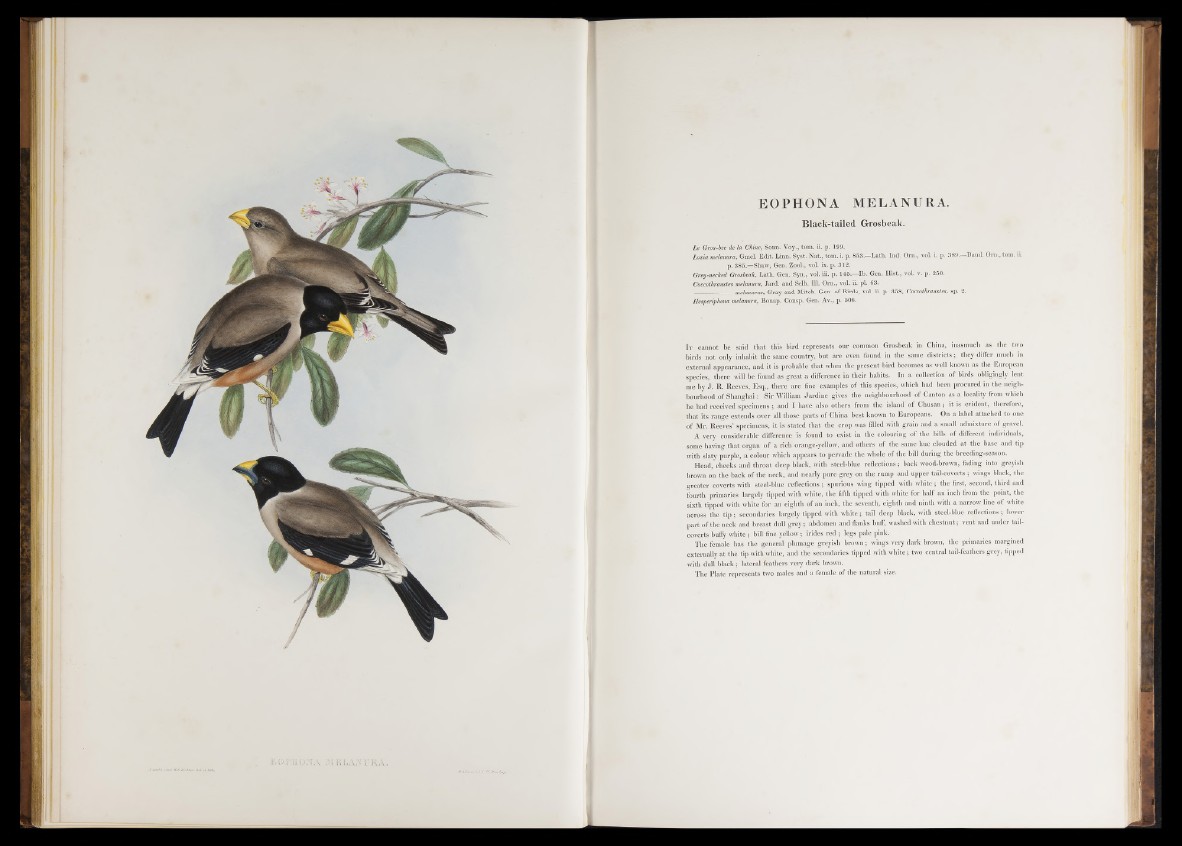
EOPHONA MELANURA.
Black-tailed Grosbeak.
Le Gros-bec de la Chine, Sonn. Voy., tom. ii. p. 199.
Loxia melanura, Gmel. Edit. Linn. Syst. N a t, tom. i. p. 853.—Lath. Ind. Orn., vol. i. p. 389.—Daud. Orn., tom. ii.
p. 385.—Shaw, Gen. Zool., vol. ix. p. 312.
Grey-necked Grosbeak, Lath. Gen. Syn., vol. iii. p. 145.— lb . Gen. Hist., vol. v. p. 250.
Coccothraustes melanura, Jard . and Selb. 111. Om., vol. ii. pi. 63.
____________ melanurus, Gray and Mitch. Gen. o f Birds, vol. ii. p. 358, Coccothraustes, sp. 2.
Hesperiphona melanura, Bonap. Consp. Gen. Av., p. 506.
I t cannot be said that this bird represents our common Grosbeak in China, inasmuch as the two
birds not only inhabit the same country, but are even found in the same districts; they differ much in
external appearance, and it is probable that when the present bird becomes as well known as the European
species, there will be found as great a difference in their habits. In a collection of birds obligingly lent
me by J . R. Reeves, Esq., there are fine examples of this species, which had been procured in the neighbourhood
o f Shanghai: Sir William Jardine gives the neighbourhood of Canton as a locality from which
he had received specimens; and I have also others from the island of Chusan; it is evident, therefore,
th at its range extends over all those parts of China best known to Europeans. On a label attached to one
o f Mr. Reeves’ specimens, it is stated that the crop was filled with grain and a small admixture of gravel.
A very considerable difference is found to exist in the colouring of the bills of different individuals,
some having that organ of a rich orange-yellow, and others of the same hue clouded a t the base and tip
with slaty purple, a colour which appears to pervade the whole of the bill during the breeding-season.
Head, cheeks and throat deep black, with steel-blue reflections; back wood-brown, fading into greyish
brown on the back of the neck, and nearly pure grey on the rump and upper tail-coverts ; wings black, the
greater coverts with steel-blue reflections; spurious wing tipped with wh ite ; the first, second, third and
fourth primaries largely tipped with white, the fifth tipped with white for half an inch from the point, the
sixth tipped with white for an eighth of an inch, the seventh, eighth and ninth with a narrow line of white
across the t ip ; secondaries largely tipped with white; tail deep black, with steel-blue reflections; lower
p a rt o f the neck and breast dull g rey ; abdomen and flanks buff, washed with chestnut; vent and under tail-
coverts buffy white ; bill fine yellow; irides red ; legs pale pink.
The female has the general plumage greyish brown; wings very dark brown, the primaries margined
externally a t the tip with white, and the secondaries tipped with w hite; two central tail-feathers grey, tipped
with dull black; lateral feathers very dark brown.
The Plate represents two males and a female of the natural size.